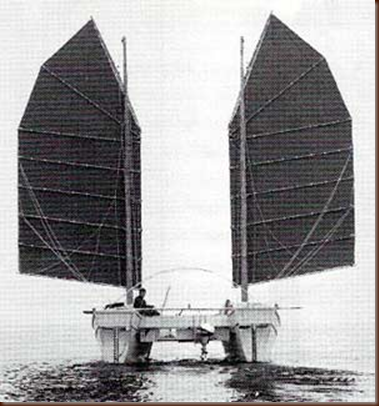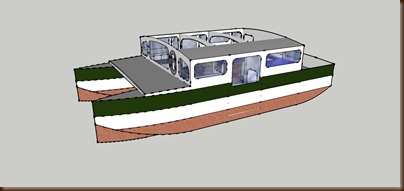Summer of 2006: it’s 3 am and we’re drifting about 60 miles off Cape San Blas in the northwest gulf of mexico. Bob is up sitting in the cockpit marvelling that Dan can sleep below since we are firmly in the trough wallowing in a 6 foot swell. All that lead in the Pearsons keel is doing some jolly swinging to and fro and there’s basically nothing I can do about it. It’s windless and glassy so no way to put up any kind of riding rig and if I did, hoping for a breeze, the junk sails yard would be banging to and fro also. It’s one of those classic panhandle nights that swelter and it’s just more humane to be up here instead of wringing what relief a little DC fan can bring below.
Down about 60 feet the white sand expanse stretches for miles in a flat plain. Too deep to really anchor out with any kind of efficiency and with the 1/2 knot current we’d probably wander around the anchor endlessly anyway. So we’re basically hove –to for the night.
Engineless blues, baby!!!!!! We’re sailing from Apalachicola around to Panama City to address the jack up diesel in PC. A little sample of what it must be like to sweat out a horse latitudes night in the doldrums way out at sea in a keel boat.
And a strong case for a catamaran!!!
I love the idea of cats: awesome ride for one. And in this case it would mean no wallowing and much better sleeping: probably on deck to boot in that eminently usable space between the hulls. No need to go off on the cats ride as it is well documented. We’d probably be better rested too since the days sailing would have been much kinder on our bodies and, possibly, we’d be in freakin port already, anchored up, since our speed would have been a shitpot better all day too.
Wah, wah, wah….. crybaby blues boy….. tough it out. Man-o-the-sea and all that. But hey, isn’t it seamanlike to maximize crew comfort and efficiency?
OK…… second bit of evidence.
Winter 2000: Bob has signed on with a guy who needs to deliver his 36 foot lead keel sloop from Mazatlan to San Diego. It’s been pretty peachy across the sea of cortez mouth but once around and up the western baja side it gets just plain cold and gnarly with consistent headwinds. Known as the “baja bash” this is no milk run. The skipper is on the green side, as am I at the time (sail vessel wise anyway and this ain’t no deep sea tug now, bub), and he wants to do all the sail shortening, which he is reluctant to do at night because he is generally clumsy at it, so we sail a lot with the wrong canvas up.
Wish we had a junk rig!!! Watching that guy go forward and do a near chaotic ballet, in a 8 foot wind chop, on the treacherously textured deck and cabin top was pretty instructive. I know the junk rig well now, years later, after using it on two different boats we have owned, and that green skipper could have mightily benefitted from doing everything from the safety of the cockpit. He would have reefed far earlier and on his slightest whim (actually he’d have slept through it because it’s so easy he would have let me do it). We’d have sailed a bit more off the wind but so what?
So…… a strong case for a junk rigged cat. Safe and secure platform for crew efficiency and rest. And reefing easy as can be. Toss in the speed, unsinkability, that awesome center area in port for great breezes and a ton of kayaks and such, the ultra shoal draft and beaching ability, and the fun factor and it’s a virtual no brainer. Cats rigged with the junk sails in each hull have been proven to go to windward. Even a traditional marconi rigged cat is easy to reef given the more even ride and flat center space to work in a reef.
This is Dave Zeigers cat concept, loosely based on his flat section sail barges. 40 feet long and made of full 4X8 plywood sheets. Daves hulls come out at a respectable 10:1 WL beam to length ratio for speed. This one is a coaster given that exposed house but the concept is workable with a bit of tweaking and well suited to the bi-plane rigged lugsail configuration. The hulls could actually be done Oregon dory style to give a bit more interior room and presents a open center deck for all manner of in port luxury. Tacking might be a bitch with all that straight run and hard chines but the concept was proven with this boat below:
This was designed to fold up for trailering and is also about 40 feet long. Can’t say there is much room for living aboard for any length of time though! This one was fast though, as I recall. Gary Lepaks cat, pictured again below, had 8:1 volumous hulls in a 37 foot length overall and traded speed (down to traditional hull speed formulas) for load carrying ability and living room in the hulls. It had the same fine open center deck though and the same great cat ride and made a run from alaska to baja with no problems.
So…. there we go. Idle speculation at 4 am on a windy, dark alaska night. Makes a lot of sense to me though and the quick to build plywood sheet construction of Daves trilo-cat design kinda itches my building bone anew. Oh well…. time to go to bed. Boatbuilders know this nocturnal ruminating well! Can’t help but dream about this boat in the islands and cayes of Panama, Cuba, and whatnot. Hmmm, hmmmm, hmmmmmmmmmmmmm.
Hey…. where did my ballasted boat go???????






Hey Joe,
ReplyDeleteAs you know my wife is an epidemiologist here in Chiapas. She remembers running around in jungle communities 30 years ago when the incidence of malaria was very high. Now all of Chiapas gets maybe 100 cases a year. With a total population of 2 million people you're more likely to get struck by lightening. Of course that ratio goes up a bit when you break the population down into low land Anopheles breeding grounds but still it's relatively rare.
If you don't want to get malaria the best precaution are to not get bit at dusk or at dawn when Anopheles mosquitoes are active. But here at least malaria is pretty rare. Of course if you stay away from human areas that works also. The safest place is in the middle of the jungle where there are no inhabitants. Mosquitoes live in human environments since they need their blood to propagate. People also leave old tires full of water and such things around for breeding grounds.
Dengue is actually a more severe problem though not generally life threatening. It's mutating also and now you can get the hemorrhagic form without going through the stage one form first. Not surprisingly Cancun has one of the highest transmission rates of Dengue in the entire country. Of course the press doesn't broadcast that fact. But even still it's relatively low for the population. How much news have you seen in the states of some tourist bringing back Dengue?
But in summary malaria is kind of a non issue in Chiapas. There were 15 cases in the Comitán jurisdiction all of last year and they were in the low lands around the Angostura dam or over near Maravilla Tenejapa on the Guatemalan border before the mountains climb up to the sky.
Based on that you are at higher risk taking the anti-malarials which are pretty toxic than getting the disease.
Dan